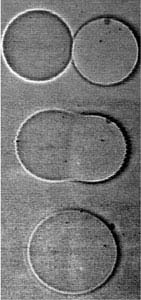Tiny ’test tubes’ may aid pharmaceutical R&D

A series of three photos show two lipsomes fusing into one. <br>
Using laser light as tweezers and a scalpel, scientists from the National Institute of Standards and Technology (NIST) have demonstrated the use of artificial cells as nanovials for ultrasmall volume chemistry. The approach may be useful for faster, cheaper identification of new pharmaceuticals and for studying cellular-level processes. The researchers will report their results in the Sept. 30 edition of Langmuir.
The artificial cells, called liposomes, are tiny spherical containers that self-assemble from natural fats (phospholipids and cholesterol). Measuring micrometers in diameter, the fluid-filled membranes are currently used in cosmetics and for drug delivery.
The NIST team developed an improved method for using liposomes as tiny test tubes for mixing chemicals with volumes measured in trillionths of liters. Their experimental setup allows simultaneous trapping of two liposomes without deforming or stressing their membranes, a problem with some other techniques. They used pairs of infrared lasers (“optical tweezers”) to bring two liposomes into contact and a single ultra-violet laser pulse (the “optical scalpel”) to fuse the two cells together. Once fused, the contents of the two cells mix and react. One liposome in each pair contained fluorescent dye, and the other contained calcium ions. After the cells merged, fluorescence increased as a result of the reaction between the dye and the ions.
The optical scalpel achieves cleaner fusion and less leakage of contents than the typical technique using pulsed electric fields. The liposomes fully enclose their reactant chemicals, minimizing evaporation. Consequently, the technique also may be useful for quantitative studies of chemical reactions involving samples in the quadrillionths of liters.
Media Contact
All latest news from the category: Process Engineering
This special field revolves around processes for modifying material properties (milling, cooling), composition (filtration, distillation) and type (oxidation, hydration).
Valuable information is available on a broad range of technologies including material separation, laser processes, measuring techniques and robot engineering in addition to testing methods and coating and materials analysis processes.
Newest articles

Compact LCOS Microdisplay with Fast CMOS Backplane
…for High-Speed Light Modulation. Researchers from the Fraunhofer Institute for Photonic Microsystems IPMS, in collaboration with HOLOEYE Photonics AG, have developed a compact LCOS microdisplay with high refresh rates that…

New perspectives for material detection
CRC MARIE enters third funding period: A major success for terahertz research: Scientists at the University of Duisburg-Essen and the Ruhr University Bochum have been researching mobile material detection since…

CD Laboratory at TU Graz Researches New Semiconductor Materials
Using energy- and resource-saving methods, a research team at the Institute of Inorganic Chemistry at TU Graz aims to produce high-quality doped silicon layers for the electronics and solar industries….



